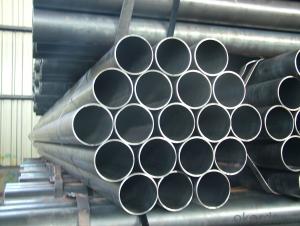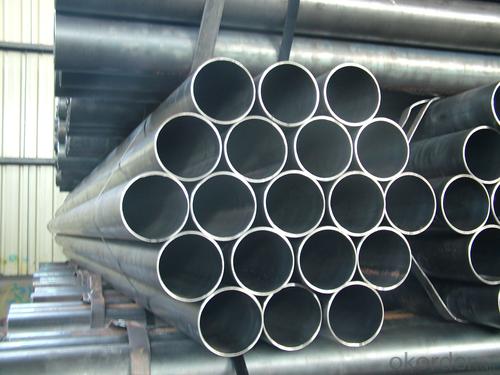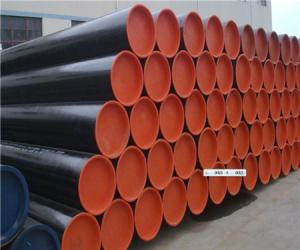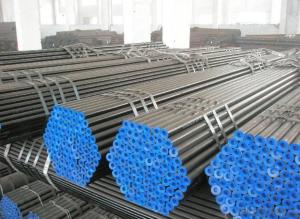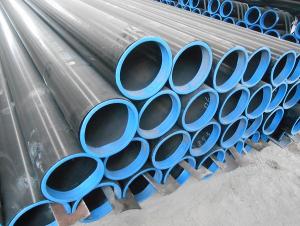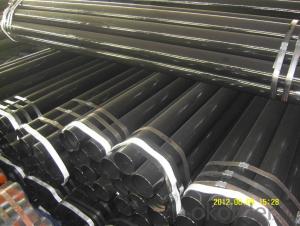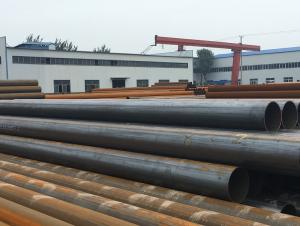Roller pipes
- Loading Port:
- China Main Port
- Payment Terms:
- TT OR LC
- Min Order Qty:
- -
- Supply Capability:
- -
OKorder Service Pledge
OKorder Financial Service
You Might Also Like
Outside diameter | 1/2”-12” |
Wall Thickness | 1.0 -12mm SCH40,60,80, etc. |
Tolerance | ±5% |
Material | Q195,Q215,Q235,Q345 |
Quality grade | First grade |
Section Shape | Round |
Surface Treatment | Hot rolled and ERW |
Technique | Hot rolled |
Ends | Threaded Ends, Grooved Ends |
Length | Less than 12m |
MOQ | 10 Metric Ton or as your request if normal size |
Deliver Time | Stock |
Package | Nude pipe in bundle or as your request |
Payment terms | T/T,L/C |
Standard | GB/T3091-2008; BS1837-1985; ASTM A53/A53M-07; ASTM A513-07; ASTM A252; JIS G3444-06; JIS G3452-2010; EN10255; DIN2440 |
Main Usage Relevant Size | 1. Water Pipe Material: Q195/Q215/Q235/Q345B Outside Diameter: 60-273mm 2. Threaded/Screwed Pipe Material: Q195/Q215/Q235/Q345B Outside Diameter: 21.3-165.1mm 3. Structural Steel Pipe Material: Q195/Q215/Q235/Q345B Outside Diameter: 21.7-190.7mm 4. Scaffolding Pipe Material: Q195/Q215/Q235/Q345B Outside Diameter: 48mm 5. Straight Seam Welded Pipe Material: Q195/Q215/Q235/Q345B Outside Diameter: 48-273mm 6. Steel pipes with a longitudinal ERW Material: Q195/Q215/Q235/Q345B Outside Diameter: 21.3-273.1mm Standard: GB/T 3091-2008 |
- Q: How are steel pipes used in the fabrication of storage tanks?
- Due to their strength, durability, and versatility, steel pipes are widely employed in the construction of storage tanks. Throughout the tank fabrication process, these pipes serve various functions. To begin with, steel pipes are utilized in establishing the tank's foundation. By providing a robust base, they ensure stability and prevent potential structural problems. Moreover, steel pipes are employed in constructing the tank's shell. Through welding, these pipes are joined together to form a cylindrical structure capable of withstanding the pressure and weight of the stored material. Furthermore, steel pipes are crucial for installing inlet and outlet pipes. These pipes enable the controlled flow of materials in and out of the storage tank. Additionally, steel pipes frequently play a role in fabricating support structures within the tank. These structures distribute the weight of the stored material and offer additional reinforcement to the tank. When it comes to maintenance and repair, steel pipes are also essential. They are used to install access points such as manholes or inspection ports, facilitating routine inspections, cleaning, and any necessary repairs. In summary, steel pipes are indispensable in the fabrication of storage tanks, providing a resilient and dependable framework. They are employed in constructing the tank's foundation, shell, inlet and outlet pipes, support structures, and access points. With their durability and versatility, steel pipes ensure the integrity and functionality of storage tanks.
- Q: What is the difference between steel pipes and PPR pipes?
- Steel pipes and PPR (Polypropylene Random Copolymer) pipes are two different types of pipes commonly used in various industries and applications. The main difference lies in their material composition and properties. Steel pipes are made from steel, a strong and durable metal. They are known for their high tensile strength, resistance to extreme temperatures, and ability to withstand high pressure. Steel pipes are commonly used for transporting fluids and gases in industries such as oil and gas, construction, and plumbing. On the other hand, PPR pipes are made from a type of plastic called polypropylene random copolymer. PPR pipes are known for their excellent thermal and chemical resistance, as well as their light weight and easy installation. They are commonly used for hot and cold water supply systems, as well as in heating and cooling applications. In summary, the key difference between steel pipes and PPR pipes lies in their material composition and properties. Steel pipes are stronger and more suitable for high-pressure and extreme temperature applications, while PPR pipes are lighter, easier to install, and ideal for water supply systems.
- Q: Why can't stainless steel be put together with carbon steel tube?
- Stainless steel can not be put together with carbon steel because of galvanic corrosion
- Q: What is the fatigue strength of steel pipes?
- The fatigue strength of steel pipes refers to the maximum stress level that the pipes can endure without experiencing fatigue failure or damage over a given number of stress cycles. It varies depending on factors such as the steel composition, manufacturing process, pipe dimensions, and environmental conditions.
- Q: What are the different manufacturing standards for steel pipes?
- Various manufacturing standards for steel pipes are widely recognized and implemented in the industry, ensuring that specific requirements and quality standards are met. Some of the most common standards for steel pipes are as follows: 1. ASTM (American Society for Testing and Materials): Widely used in the United States, ASTM standards encompass a wide range of steel pipe specifications. These standards include specifications for seamless and welded pipes, as well as different grades and dimensions. 2. ISO (International Organization for Standardization): Globally recognized, ISO standards provide guidelines for steel pipe production. They cover areas such as dimensions, materials, testing, and quality control. 3. EN (European Norm): Applicable in Europe, EN standards specify various types of steel pipes. They cover dimensions, materials, manufacturing processes, and testing. 4. JIS (Japanese Industrial Standards): Widely used in Japan and internationally recognized, JIS standards cover dimensions, materials, and testing methods for steel pipes. 5. BS (British Standards): Commonly used in the United Kingdom, BS standards encompass a range of steel pipe specifications. They include requirements for dimensions, materials, and testing procedures. 6. API (American Petroleum Institute): Specifically developed for the oil and gas industry, API standards cover different aspects of steel pipe manufacturing. They include specifications for seamless and welded pipes used in oil and gas exploration, production, and transportation. Manufacturers, buyers, and users of steel pipes should be aware of these standards to ensure the quality, compatibility, and reliability of the pipes. Compliance with these standards helps to ensure that the steel pipes meet necessary requirements and are suitable for their intended applications.
- Q: Can steel pipes be used for underground fire hydrants?
- No, steel pipes are not typically used for underground fire hydrants. Underground fire hydrants are usually constructed using ductile iron pipes as they provide greater strength, durability, and resistance to corrosion, ensuring reliable water supply during emergencies.
- Q: Is the diameter of the steel tube indicated by the outer diameter by the wall thickness or by the inside diameter by the wall thickness?
- The specification for steel tubes is the outer diameter multiplied by the wall thickness.Generally speaking, the diameter of the pipe can be divided into outer diameter (De), inner diameter (D) and nominal diameter (DN).
- Q: What place must use galvanized steel pipe to make lighting line?
- Galvanized steel pipe with hot-dip galvanizing or galvanized coating on it. Galvanizing can increase the corrosion resistance and prolong the service life of the steel pipe. The use of galvanized pipe is very wide, except for water, gas, oil and other general low pressure fluid pipeline, is used in petroleum industry especially offshore oil well pipe and oil pipe, chemical coking equipment oil heater, cooler, oil pipe exchanger for coal distillation, and support piles, Zhanqiao mine tunnel the tubes.
- Q: Can steel pipes be used for sewage systems?
- Yes, steel pipes can be used for sewage systems. Steel pipes are commonly used in sewage systems due to their durability, strength, and resistance to corrosion. They are particularly suitable for high-pressure applications and can withstand the harsh conditions often found in sewage systems. Additionally, steel pipes are relatively easy to install and maintain, making them a popular choice for sewage infrastructure projects.
- Q: How are steel pipes connected to other materials like concrete or plastic?
- Steel pipes can be connected to other materials like concrete or plastic through various methods such as welding, flanges, threaded connections, or using specialized fittings. These connections ensure a secure and durable bond between the steel pipe and the other material, allowing for effective transfer of fluids or structural support.
Send your message to us
Roller pipes
- Loading Port:
- China Main Port
- Payment Terms:
- TT OR LC
- Min Order Qty:
- -
- Supply Capability:
- -
OKorder Service Pledge
OKorder Financial Service
Similar products
Hot products
Hot Searches
Related keywords
